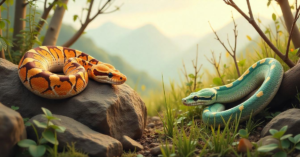Introduction
The mesmerizing world of ball python morphs has captivated reptile enthusiasts and breeders alike. These unique variations in color and pattern are not just visually stunning but also represent the genetic artistry of nature and human ingenuity. However, as climate change accelerates, the future of ball python morphs faces significant challenges. From habitat loss to breeding difficulties, understanding these impacts is crucial for ensuring the survival and prosperity of this fascinating species.
Understanding Ball Python Morphs
Popularity and Economic Significance
The trade of ball python morphs is a thriving industry, with rare morphs fetching thousands of dollars. Their popularity is not just about aesthetics; they symbolize biodiversity and genetic potential.
Climate Change and Its Impact
Climate Change Impact on Wildlife
Climate change, driven by human activities like deforestation and greenhouse gas emissions, poses a major threat to biodiversity. Reptiles like ball pythons, being ectothermic (cold-blooded), are particularly vulnerable to these changes.
Reptile Habitat Loss
Ball pythons are native to sub-Saharan Africa, where they thrive in warm and humid environments. However, climate change is altering these habitats. Increased temperatures, prolonged droughts, and habitat fragmentation due to human development are reducing the areas where wild populations can survive.
Temperature Sensitivity in Reptiles
Reptiles depend on external temperatures to regulate their body heat. Climate-induced temperature fluctuations can disrupt their physiology, impacting growth, reproduction, and survival rates. This sensitivity also extends to egg incubation, where precise temperature ranges are critical for healthy development.
Challenges in Ball Python Breeding
Ball Python Breeding and Climate Change
Captive breeding has been a cornerstone of the ball python trade, enabling breeders to produce and refine morphs. However, climate change introduces new hurdles. Maintaining controlled environments becomes more challenging as external conditions grow increasingly unpredictable.
Captive Breeding Challenges
- Temperature Regulation: Breeding ball pythons requires stable environmental conditions, particularly during incubation. Even slight temperature deviations can result in deformities or reduced hatchling survival rates.
- Resource Dependency: Rising energy costs and resource scarcity could complicate efforts to sustain ideal breeding conditions.
- Health Impacts: Stress caused by environmental instability can weaken immune systems, making snakes more susceptible to disease.
Genetic Diversity in Captivity
Genetic diversity is essential for the long-term health and resilience of any species. Breeding programs must prioritize diverse genetic lines to prevent inbreeding and ensure the adaptability of ball python populations.

Wildlife Adaptation and Conservation Efforts
Adaptation in the Wild
Wild ball pythons may struggle to adapt to rapid environmental changes. Shifting rainfall patterns, reduced prey availability, and shrinking habitats force these reptiles to navigate uncharted ecological territories.
Reptile Conservation Programs
Conservation efforts are critical for preserving wild populations. Protected reserves, habitat restoration, and educational programs can help mitigate the effects of climate change on ball pythons. These initiatives also play a vital role in ensuring that wild populations remain genetically robust.
Economic and Ethical Implications
Economic Impacts on Ball Python Morphs
As climate change disrupts breeding practices, the economic landscape of the ball python trade may shift. Rare morphs could become even more valuable, while supply chain disruptions might affect availability and pricing.
Ethical Considerations
Breeders face ethical questions about sustainability and animal welfare. Balancing commercial interests with the well-being of the species is a pressing challenge in an era of ecological uncertainty.
Sustainable Breeding Practices
Technological Innovations
Advances in breeding technology, such as climate-controlled enclosures and improved genetic testing, offer solutions for adapting to climate change. These innovations can help breeders maintain stable environments and optimize breeding outcomes.
Focus on Sustainability
Sustainability must be at the forefront of breeding practices. This includes reducing energy consumption, sourcing ethical supplies, and prioritizing the welfare of the animals over commercial gain.
Collaboration Across Borders
Global collaboration among breeders, conservationists, and researchers is essential for addressing the challenges posed by climate change. Sharing knowledge and resources can foster more effective strategies for ensuring the long-term survival of ball python morphs.
The Future of Ball Python Morphs
The future of ball python morphs will depend on our ability to adapt and innovate. Climate change presents significant challenges, but it also offers an opportunity for breeders and conservationists to work together in safeguarding this remarkable species. By prioritizing ethical practices, embracing technology, and supporting conservation efforts, we can ensure that ball python morphs continue to thrive in the face of environmental change.
Conclusion
Climate change poses undeniable risks to the future of ball python morphs, from habitat loss to challenges in breeding. However, by addressing these issues proactively through conservation efforts, technological advancements, and sustainable practices, we can secure a brighter future for these incredible reptiles. The responsibility lies with all of us—breeders, hobbyists, and conservationists alike—to act now for the continued survival of this species.
FAQs
What are ball python morphs?
Ball python morphs are genetic variations that create unique color and pattern combinations in ball pythons.
How does climate change affect ball pythons?
Climate change disrupts their natural habitats, breeding cycles, and survival rates due to temperature sensitivity and habitat loss.
What are the challenges of breeding ball pythons in captivity?
Breeders face challenges like maintaining temperature stability, ensuring genetic diversity, and managing health issues due to environmental stress.
Why is genetic diversity important in ball python breeding?
Genetic diversity prevents inbreeding and ensures the adaptability and health of populations in changing environments.
How can we support the conservation of ball pythons?
Supporting ethical breeding practices, donating to conservation programs, and raising awareness about habitat protection are all critical steps.
Can ball pythons adapt to climate change on their own?
While ball pythons have some adaptability, rapid environmental changes caused by climate change may outpace their ability to adjust, making conservation efforts crucial.
What role do hobbyists play in ball python conservation?
Hobbyists can support conservation by choosing ethical breeders, spreading awareness, and participating in initiatives that protect wild populations.
Are there specific morphs more vulnerable to climate change?
Morphs with genetic traits tied to specific environmental conditions may be more susceptible to climate-related changes, emphasizing the need for diverse and robust breeding practices.




